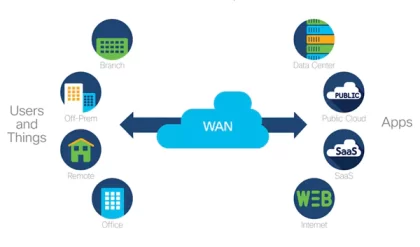Packet switching is the transfer of small pieces of data across various networks. These data chunks or “packets” allow for faster, more efficient data transfer.
Often, when a user sends a file across a network, it gets transferred in smaller data packets, not in one piece. For example, a 3MB file will be divided into packets, each with a packet header that includes the origin IP address, the destination IP address, the number of packets in the entire data file, and the sequence number.
Types of Packet Switching
There are two major types of packet switching:
Connectionless Packet Switching. This classic type of packet switching includes multiple packets, each individually routed. This means each packet contains complete routing information—but it also means different paths of transmission and out-of-order delivery are possible, depending on the fluctuating loads on the network’s nodes (adapters, switches and routers) at the moment. This kind of packet switching is sometimes called datagram switching.
Each packet in connectionless packet switching includes the following information in its header section:
- Source address
- Destination address
- Total number of packets
- Sequence number (Seq#) for reassembly
Once the packets reach their destination via various routes, the receiving devices rearrange them to form the original message.
Connection-Oriented Packet Switching. In connection-oriented packet switching, also called virtual circuit switching or circuit switching, data packets are first assembled and then numbered. They then travel across a predefined route, sequentially. Address information is not needed in circuit switching, because all packets are sent in sequence.
What is Packet Loss?
Occasionally, packets might bounce from router to router many times before reaching their destination IP address. Enough of these kinds of “lost” data packets in the network can congest it, leading to poor performance. Data packets that bounce around in the network too many times may get lost.
The hop count addresses this problem, setting a maximum number of bounce times per packet. “Bouncing” simply refers to the inability to locate the final destination IP address, and the resulting transfer from one router to another instead. If a certain packet reaches its maximum hop count, or maximum number of hops it is permitted before reaching its destination, the router it is bouncing from deletes it. This causes packet loss.
Circuit Switching vs Packet Switching
Packet switching and circuit switching are the primary models for facilitating enterprise network connections. Each mode has its place, depending on the facts and user needs.
Circuit switching is most often used for voice and video calling systems—communications systems that require that users establish a dedicated circuit or channel before they can connect. A circuit switching channel is always reserved, and is in use only when the users are communicating.
Circuit switching connections might allocate one or two channels for communications. Those with one channel are called half duplex. Those with two channels are full duplex.
Circuit switching is different from packet switching because it creates a physical path between the destination and source. There is no physical path in packet switching, which instead sends packets over a variety of routes.
Advantages of Packet Switching over Circuit Switching
Advantages of Packet Switching over Circuit Switching:
Efficiency. Improved efficiency means less network bandwidth wastage. No need to reserve the circuit even when it’s not in use means the system is more efficient. A constantly reserved circuit results in wasted network bandwidth, so network efficiency tends to increase with the use of packet switching.
Speed. Optimal transmission speed, minimal latency.
Improved fault tolerance. During partial outages or other network problem times, packets can be rerouted and follow different paths. Using a circuit switching network, a single outage can down the designated pathway for the communications.
Budget. Comparatively cost-effective and simple to implement. Packet switching typically also bills based only on duration of connectivity, whereas circuit switching bills on both duration of connection and distance.
Digital. Packet switching works well for data communication, transmitting digital data directly to its destination. Data transmissions are generally high quality in a packet switched network because such a network employs error detection and checks data distribution with the goal of error free transmissions.
Disadvantages of Packet Switching over Circuit Switching:
Reliability. The packet switching process is reliable in that the destination can identify any missing packets. However, circuit switched networks deliver packets in order along the same route and are therefore less likely to experience missing packets in the first place.
Complexity. Packet switching protocols are complex, so switching nodes demand more processing power and a large amount of RAM.
File size. Packet switching is more useful for small messages, while circuit switching is best for larger transmissions. This is due to multiple rerouting delays, the risk of multiple lost packets, and other issues.
Cell Switching vs Packet Switching
Cell switching, or cell relay, uses a circuit switching network and has features of circuit switching. The primary difference is that in packet switching technology, the packets are of variable lengths, but in cell switching, packets are a fixed length of 53 bytes with a 5 byte header.
Advantages of cell switching include dynamic bandwidth, high performance, scalability, and the ability to use common LAN/WAN architecture multimedia support. Cell switching achieves high performance using hardware switches. There is no need to reserve resources in computer networks for a connection since the technology uses virtual rather than physical circuits. And after establishing a virtual circuit, you can achieve higher network throughputs thanks to minimized switching time.






Comments are closed.